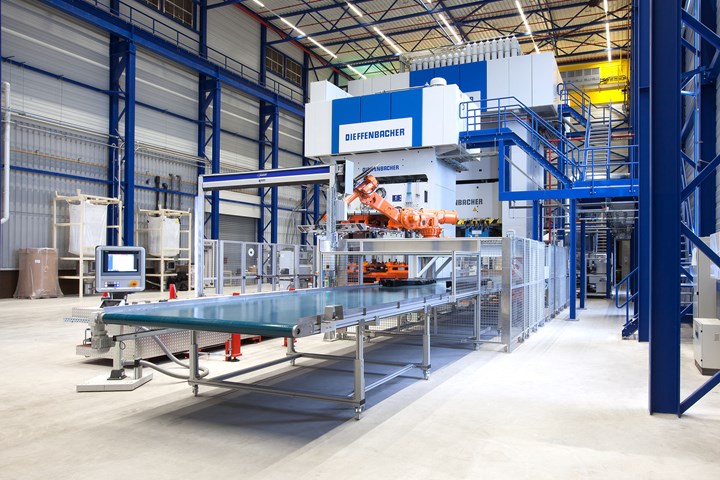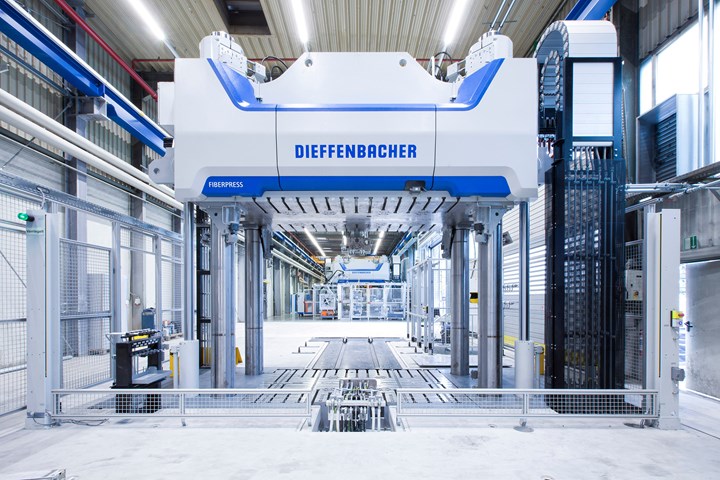Novel Single-Extruder Line For Direct Long-Fiber Thermoplastics
Dieffenbacher builds single-extruder line for LFT-D to compound recycled materials as powder, chips or pellets.
Dieffenbacher has built what is said to be a first-of-its-kind extrusion line for “direct” inline-compounded, long-fiber thermoplastic (LFT-D). It reportedly will be the highest capacity line of its type and will enable molding of higher volumes of thermoplastic components than previously possible. The extrusion line will be packaged with a hydraulic press from Dieffenbacher’s Fiberpress series for delivery to an undisclosed U.S. customer in 2021.
This innovative line, developed collaboratively by Dieffenbacher’s Composites and Recycling business units, is said to be unique in that it will produce LFT-D extrudates using only one twin-screw extruder. The machine’s L/D ratio varies depending on the application, the required throughput, the glass-fiber content and the polymer. Recycled polymers from post-consumer and post-industrial streams will be used as the raw material, such as HDPE, LDPE, PP or PET in powder, chip or pellet form. Adjustments of the dosing equipment and an adapted length of the extruder barrel reportedly will enable the plant to efficiently and economically produce thermoplastic components from 100% recycled material.

Melting, fiber incorporation and cutting/mixing is done with one extruder in this unique LFT-D line.
As Dieffenbacher explains, a typical LFT-D line consists of a two-stage extrusion process requiring one extruder for melting the polymer and a second extruder for mixing the fiber the pre-melted polymer. “In this project, a second extruder is not required. Melting, fiber incorporation and cutting/mixing can be done within one machine,” says Marco Hahn, director of sales for the Composites Business Unit.
This single unit does not extrude into the open press, explains Hahn. As with Dieffenbacher’s two-stage extrusion machine, the melt is extruded through a nozzle at the end of the extruder onto a conveyor belt. The extrudate is then picked up by a robot and placed in the lower mold half of the vertical press.
The Dieffenbacher line is supplied with a 2500-m.t. Fiberpress. The U.S. customer will be producing large non-automotive parts. Asked about the line’s output capacity, Hahn says it depends on the final product size and working scheme, but will be in the range of approximately 300,000 to 400,000 parts/yr. “Our combination of a unique technological concept and the use of recycled raw material convinced this customer to select Dieffenbacher.”

Dieffenbacher’s LFT-D line for a U.S. customer includes one of the company 2500-m.t. Fiberpress hydraulic presses.
Related Content
-
Automotive Awards Highlight ‘Firsts,’ Emerging Technologies
Annual SPE event recognizes sustainability as a major theme.
-
Latest Data on Bottled Water Shows Continued Strong Growth
Bottled water’s volume surpassed soft drinks for the first time in 2016 and has done so every year since.
-
ICIS Launches: Ask ICIS Generative AI Commodities Assistant
Said to be the first of its kind, this AI assistant will enhance access to ICIS’ intelligence and insights for the energy and chemical markets.
















